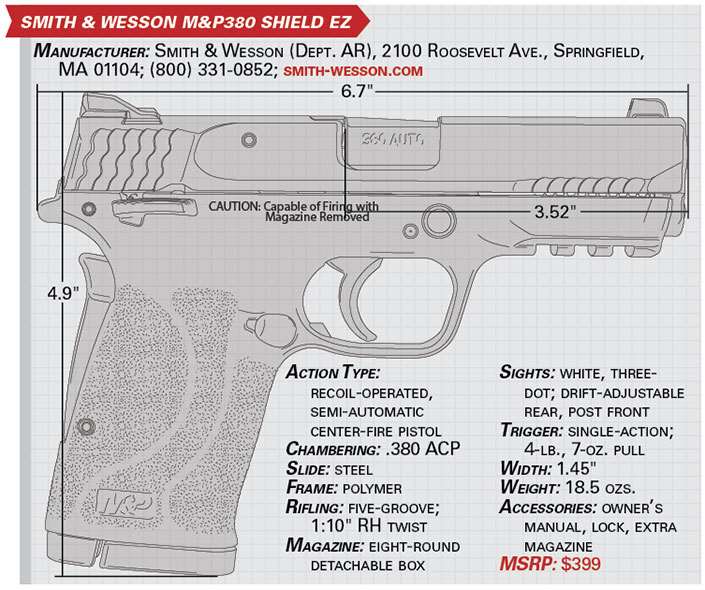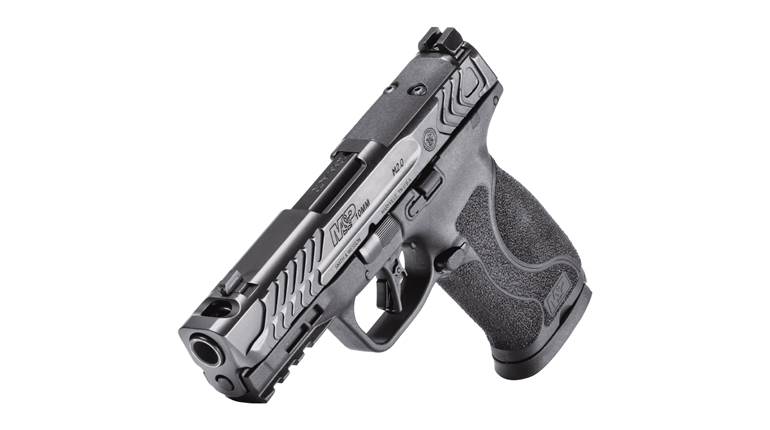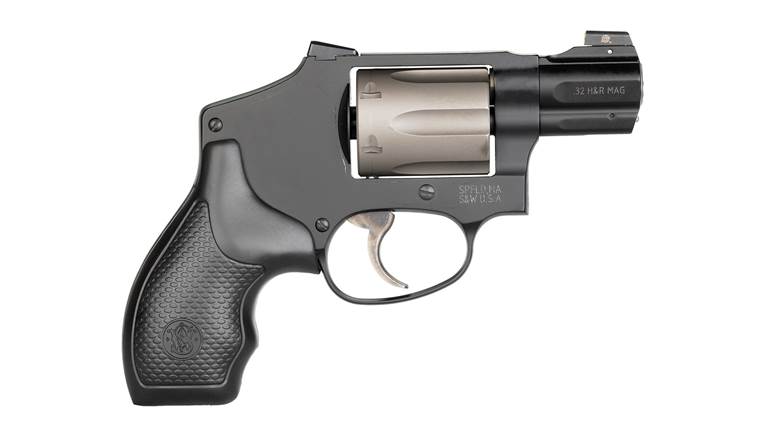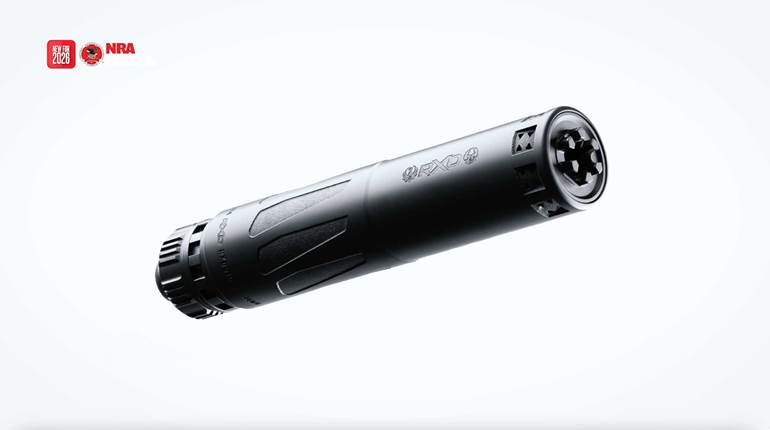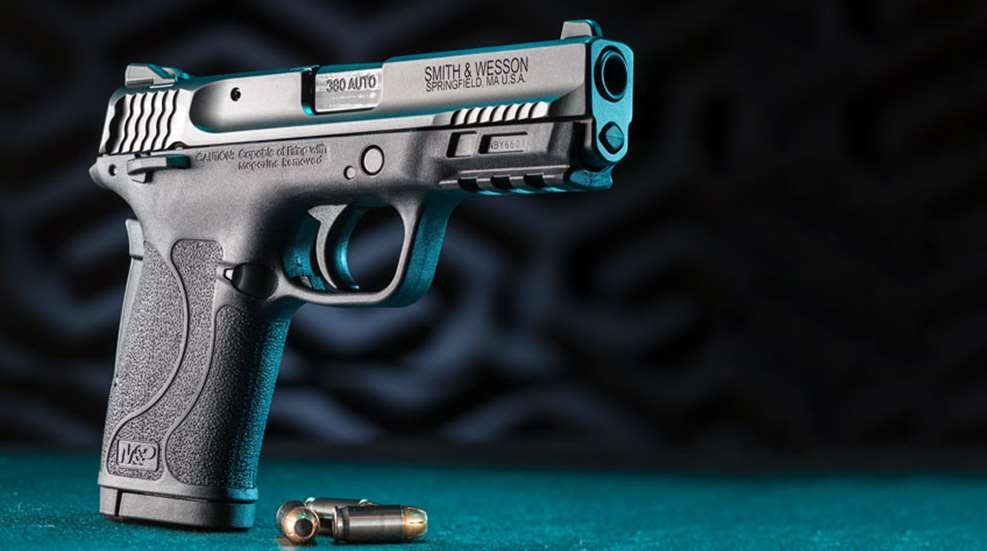
Why would I want a gun as big as a 9 mm Shield that’s only a .380?” Those words were from one of my colleagues upon seeing the Smith & Wesson M&P380 Shield EZ. “That’s simple,” I replied. “This gun’s not for you.” It’s not that Smith & Wesson wouldn’t be happy to make another sale, but a burly, decidedly opinionated, veteran gun writer was not necessarily who the company had in mind when it developed this pistol.
“When we set out to design the M&P380 Shield EZ pistol, our goal was to deliver an all-around, easy-to-use personal protection pistol—from loading and carrying to shooting and cleaning,” said S&W’s Jan Mladek. “We focused on key areas that customers told us were important—the ease of racking the slide and loading the magazine—allowing consumers of all statures and strengths the opportunity to own, comfortably practice with and effectively utilize this exciting new pistol.”
What the M&P380 Shield EZ does is make it easy for those without a lot of hand strength or manual dexterity to efficiently operate the pistol. All guns are an engineering challenge, a combination of features, price and parameters given to designers and engineers who are then expected to craft a solution. Judging from what Mladek said the goal was, my hat is off to the firm’s engineers.
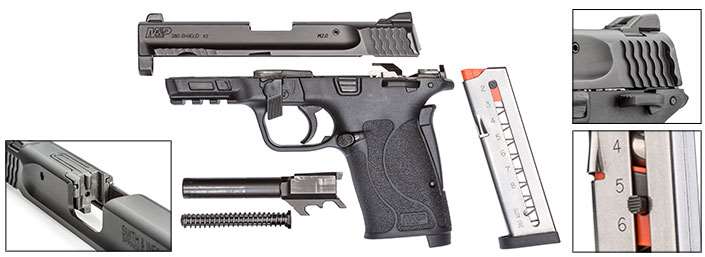
With the Smith & Wesson M&P380 Shield EZ, the compromise for ease of use is in the power of the chambering, .380 ACP, which has been around since 1908. Even with modern improvements in bullet technology, many self-defense experts still put the .380 on the bottom rung of cartridges with acceptable defensive firepower, however, in my opinion, it does make the cut. This gun is actually a little bigger than the 9 mm Luger M&P Shield—it’s 6.7" long with a 3.52" barrel and just under 5" in height. The magazine, which is very easy to load, has a capacity of eight rounds.
The combination of the .380 ACP chambering and recoil operation in a package that is compact, but not too compact, sets the EZ apart. For decades, most .380s were blowback-operated, and slide mass and recoil-spring tension were necessary to keep the gun closed to allow pressures to drop to a safe level. This started to change with George Kelgren’s Kel-Tec P-32 in .32 ACP, which, of course, was followed by the Ruger LCP and others. But those were little guns.
Some other .380s have been easy to manipulate, but not because of recoil operation. A friend and colleague, the former art director for American Hunter, bought a blowback Beretta Model 86 Cheetah in .380 because it had a tip-up barrel, and she had trouble working slides. I will be very interested to put this gun into her hands.
But it’s not just women who have difficulty “running the gun,” which I call being able to safely and competently manipulate all the controls on a pistol. No, there’s another group out there that grows every day, and that is the aging armed citizen. NRA’s Dr. Joe Logar, national manager of the Adaptive Shooting Program, gave a jam-packed presentation at the NRA Carry Guard Expo last year on that very subject, and I think he is really onto something. A large percentage of our population—an estimated 21 million Americans—suffers from arthritis, and that means they sometimes are no longer able to do things with their hands that previously would’ve been a cinch. Too, there are other shooters looking for a pistol solution, as described by NRA’s Adaptive Shooting Program: “According to the most current census data, there are approximately 74 million individuals that identify as disabled. This population is growing as the Baby Boomer generation ages and as injured soldiers return from overseas. As a group, they are generally under-represented in the shooting sports, personal protection and hunting communities.” And the EZ just may be worth a look for quite a few of them, too.
The new gun borrows from the M&P22 Compact, which is made at the firm’s Springfield, Mass., plant. This is not to be confused with the M&P22 made for S&W by Walther in Germany. The M&P22 Compact is about a 90-percent-size version of the M&P and makes for a gun with an 18-degree grip angle and excellent ergonomics. It also borrows from the center-fire M&P M2.0 stylistically in its slide lines and scallops. It has a hand-filling polymer frame—made at S&W’s Precision Components in Deep River, Conn.—with all the texturing one would expect, enough to hold onto but not enough to abrade the skin.
The recoil-operated pistol has a barrel hood that locks into the slide’s action port at its front. But this gun’s slide is very, very easy to retract. Part of that comes from its single-coil recoil spring, which gives the gun just enough energy to go back into battery without requiring the strength of an orangutan to work the slide. According to S&W’s engineers, the EZ requires less than half the force needed to rack the slide on a 9 mm Luger Shield. This really is the feature that sets the EZ apart.
Another feature the EZ has, although it spoils the lines of the gun somewhat, is a grip safety (as incorporated in the New Departure revolvers or “lemon squeezers” by Smith starting in 1887). It is pinned at the bottom and prevents the gun from firing unless depressed with a firm grip—actually, it helps one get a proper high grip in my opinion. But the grip safety does more than just act as a safety. If not depressed, the passive firing safety, which protrudes down from inside the slide, is not lifted up by its frame-mounted plunger, and the firing pin cannot move forward if hit by the hammer.
Also, the grip safety is linked to the disconnector, which acts as the go-between, a “connector” if you will, for the trigger bar—running along the inside right of the frame—and the sear. When the grip safety is depressed, the disconnector lifts the trigger bar. Then, movement of the trigger pushes the trigger bar rearward, which allows the “connector” to trip the sear and let the hammer go forward.

Although most other pistols in the M&P family are striker-fired, the EZ has an internal hammer under the slide, much like “lemon squeezers” had them inside their frames. And the EZ’s hammer is set low in the frame, requiring less effort to cock.
Trigger operation is single-action, as the hammer is fully cocked by slide movement. The trigger-pull weight and length are the same for every shot. Our sample broke at 4 lbs., 7 ozs., for an average of 10 pulls. Reset is short, although there is a discernible push by the trigger return spring. There is also an overtravel stop molded into the inside of the trigger guard. Trigger reach is about 2 1⁄8", and even the smallest-handed folks around the office had no trouble properly placing their fingers on the trigger.
The slide is of well-finished stainless steel with the firm’s proprietary black Armornite finish with scallops cut at the front and rear. Its top is 0.885" wide (but 0.995" at the rails) at the front, then it is stepped to 0.96" at its rear, giving the thumb and forefinger something to grab onto when racking the slide. Finally, there are ears cut into the very rear of the slide—bringing that dimension to 1.07"—providing the operator even more to hold onto while retracting the slide.
The breechblock is machined separately and is slid in from the front, dovetailed into the slide then fixed by a transverse roll pin. The pin bears no load, it just keeps things located properly. It also retains the internal extractor on the breech face’s right and serves as the pivot point for the loaded-chamber indicator. The fixed ejector is on the frame’s left. Shaped like a football at its front end, the splined polymer recoil spring guide rod contains the captive recoil spring and the recess for it at the slide’s front has a corresponding shape.
There is not a single chassis inside the EZ, but rather separate sub-assemblies for the fire-control unit and locking block linked by the trigger bar. Slide travel is guided by 0.65" long steel guides on either side of the locking block and by a pair of 0.50" guides at the rear.
Speaking of easy, the slide lock is not under a great deal of spring tension, either, so it’s fairly easy to depress, and even those with small hands should not have to break their grip in order to depress it. For lefties, I’m sad to report that it is not bilateral. That said, the magazine release is reversible, and detailed instructions can be found in the manual.
You can have your EZ with or without a manual safety. The bilateral manual safety version tested for this article had levers on both sides that prevented the sear from being released by the disconnector. Too, the safety levers were very easy to press both up and down, again, one of the design concepts for the gun. The gun is 1.45" wide with the levers or 1.14" wide without them. Some of our shooters, though, found that, if they gripped the frame with a proper high grip, the firing-hand thumb would engage the safety under recoil. Obviously, this could be very frustrating. The solution, if you want the belt-and suspenders piece of mind provided by a manual safety, is to put the thumb overtop its fairly wide, grooved paddle. Ride it like an extended M1911 safety, just as Col. Cooper taught us. Also, Smith has increased the tension on the safety since our sample arrived to reduce unintended activation. Owners of guns made before April 4 are eligible for a voluntary, no-cost upgrade.
The magazine borrows some design aspects from rimfire handgun magazines. It is a steel, eight-round-capacity, single-column detachable box, but to make loading easier (are you starting to see a theme here?) there are tabs on both the left and right sides (the left protrudes a little farther) that allow the orange plastic follower to be easily pulled down.
When it comes to fieldstripping, again, the EZ lives up to its moniker. Remove the magazine, retract the slide to make sure the chamber is empty, engage the slide lock, turn down the takedown lever on the frame’s left, then let the slide go forward. You don’t need to pull the trigger. Simply turn the slide upside down and remove the recoil spring and guide rod, then the barrel. Reassembly is a snap, too.
The metal-injection-molded rear sight is dovetailed into the slide, and it has two dots on its rear face. To adjust it for windage, retract the slide then loosen the set screw in the bottom, allowing the rear sight to be moved in either direction. Then simply tighten the screw, and you are in business. The front sight also has a white dot, and it has a retaining screw on the underside of the slide as well; it is replaceable but not adjustable.
Throughout this gun, Smith & Wesson designers intended to address every major concern that those without a lot of upper body strength have when it comes to manipulating a pistol. I’m not sure who gets the gold star for the name EZ but, indeed, this gun is easy to use.
Last year, American Rifleman’s Ladies Pistol Project (September 2017, p. 72) determined that many women would really prefer to use a semi-automatic pistol rather than a revolver. For many women, this pistol might reinforce that sentiment by further facilitating slide manipulation and encouraging confidence while handling. Had the EZ been available then, I think it would have placed highly on the ladies’ list.
Remember, this gun is engineered to a specific set of design parameters. As with any defensive or carry gun, potential owners need to make sure the ammunition they intend to use works reliably in their particular gun. In the gun’s first 200 rounds of function firing, there were four stovepipes with Inceptor 56-gr. ARX and two instances of the SIG Sauer V-Crown failing to feed. There was one failure to feed, a stovepipe, the last live round in a magazine, with 95-gr. American Eagle FMJ. After cleaning and lubrication with Lucas Extreme Duty Gun Oil, there were no further failures through more than 400 rounds of additional testing. In short, after breaking in, the EZ ran like a sewing machine, digesting everything—including the same loads in the same magazine as noted above. Accuracy results are tabulated on p. 47.
In the hand, the gun barely moved, making it especially desirable for those who are recoil-sensitive. Frankly, it felt more like a .22 WMR or .32 ACP than a .380 ACP. An NRA member I spoke to last year carries a .22 WMR S&W revolver because she could not comfortably shoot small .380s without hitting the threshold of her recoil sensitivity. This pistol, especially when combined with Inceptor’s soft-shooting ARX load, might allow her to comfortably carry a more effective defensive chambering.
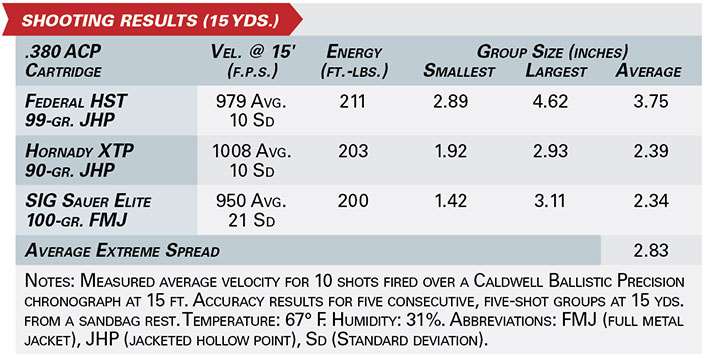
Quite a few ladies in our department are very interested in the EZ. As is one older gentleman from the second floor struggling with arthritis. Smith & Wesson is really on to something here. Instead of designing a gun specifically around the prevailing winds—smaller size and more power—Smith made the choice to offer a gun that your typical experienced pistolero might not consider. Remember that burly gunwriter? He’s not buying one for himself—but he is buying one for his mom—as am I.
